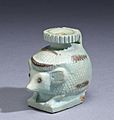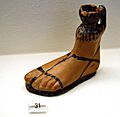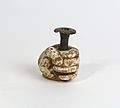Aryballos facts for kids

An aryballos (say: ah-rye-BAL-os) was a small, round bottle from Ancient Greece. People used these little flasks to hold perfume or oil. You can often see aryballoi in old Greek paintings, especially with athletes. Athletes would use them when they were bathing. Sometimes, the bottle was tied to an athlete's wrist with a strap. Other times, it hung from a peg on a wall.
How Aryballoi Changed Over Time
The idea for the aryballos came from an older Greek jar called an oinochoe (say: oy-NO-koy). This was a round wine jar from the 800s BC. Over time, the aryballos changed its look. It started out round, then became more egg-shaped, then cone-shaped, and finally went back to being round again.
The most common aryballos shape had a wide, flat opening at the top. It also had one small handle. Later on, some aryballoi had mouths shaped like bells. Others had two handles or a flat bottom. Potters, who made these bottles, also got creative. They made aryballoi in many fun and unusual shapes.
Scientists today are still studying these ancient bottles. They use special tools like CT scans and 3D scanners to learn more about how they were made.
Gallery
-
Owl-shaped, Proto-Corinthian, 630 BC
-
575–550 BC (Louvre)
-
Greco-Egyptian faience hedgehog, 6th century BC
-
Hand-shaped, Hunt Museum
-
Ancient Etruscan "aryballoi" terracotta vessels unearthed in the 1860s at Bolzhaya Bliznitsa tumulus near Phanagoria, South Russia (then part of the Bosporan Kingdom of Cimmerian Bosporus); on exhibit at the Hermitage Museum in Saint Petersburg.
See also
 In Spanish: Aríbalo para niños
In Spanish: Aríbalo para niños









